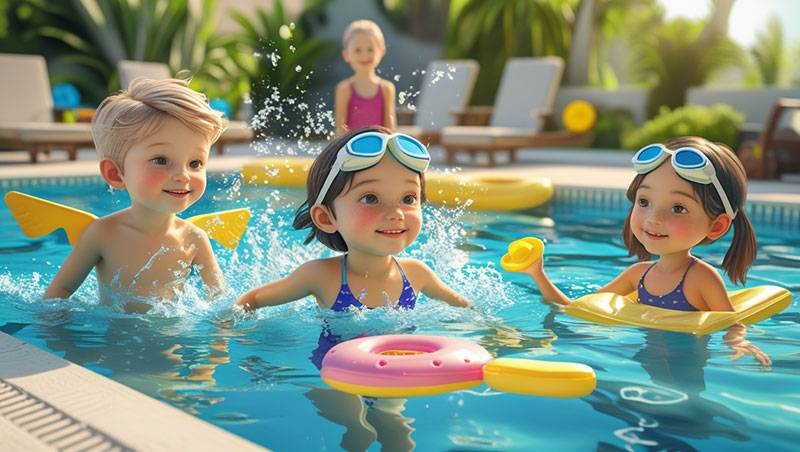Kids Swimming Safety Tips
Children’s happy and healthy activity is swimming, which also promotes physical fitness, confidence building, and often treasured family past time. Still, water fun has to always be matched with safety. For children, drowning continues to be one of the main causes of accidental injury and death; hence, water safety is an absolute obligation for every parent and guardian.
From active monitoring and water hazard awareness to the need for swimming lessons and regular pool water testing, fundamental swimming safety rules must be followed to ensure a safe environment for everyone. Families can enjoy the water while lowering risks and guaranteeing peace of mind using these ideas.
1. Supervision Must Be Constant and Undivided
The most crucial rule is never to turn away your attention from children in or close proximity to water. Active supervision is especially important for public facilities, a lake, or a backyard pool. That means keeping your attention on younger children at all times and staying within arm’s reach for them; no distractions from phones, conversations, or books.
If several adults are present, alternate in serving as the assigned “water watcher.” Turn every 15 to 30 minutes to make sure that oversight stays sharp and efficient.
2. Make Swimming Lessons a Priority
One of the most effective approaches to improve your child’s safety around water is teaching them swimming. Depending on developmental readiness, formal lessons can start at age four and babies can start water acclimation under certified teachers.
Children who receive swimming lessons pick up floating, tread water, and confident pool movement techniques. Although they won’t make a child “drown-proof,” these abilities greatly increase their chances of reacting suitably in an emergency.
3. Secure All Home Water Hazards
Children under five most often die accidentally in home pools. Make sure every water source—pools, hot tubs, fountains, even buckets—is securely fastened. At least four feet high, four-sided fences with self-closing, self-latching gates should surround pools. Install extra layers of protection—pool covers and door alarms.
Never undervalue even minor water sources. Little as two inches of water will allow children to drown. Immediately after use, empty kiddie pools; store them upside down.
4. Enforce Water Safety Rules
By teaching your children the guidelines of safe swimming, you clearly define expectations and help to lower dangerous behavior. Some main guidelines to support:
- Before you swim, always get permission.
- There is no running or rough housing close to the pool.
- Never plunge into shallow water.
- Leave right away should you see lightning or hear thunder.
5. Practice Emergency Preparedness
Every guardian or parent should be familiar with their reaction in a water crisis. Learn first aid and CPR; this ability might literally save a life. Children should swim under close proximity to a phone, and you should have reaching poles or a life ring on hand for rescue.
Even if they feel confident in water, they teach children how to call for help and make sure they grasp the risks involved. Providing knowledge to them will help to avoid panic and enhance emergency results.
6. Keep the Water Clean and Safe
Good water quality is about health not only about clarity. Neglected pools can be home to germs and parasites causing disease. Regular pool water testing is thus quite important.
Home pool owners should check water chemistry at least twice a week during maximum use and following rain showers. Keep correct pH and chlorine levels; shock the pool as necessary. Public pools should also routinely show test results; if you’re not sure, don’t hesitate to ask staff about their maintenance schedule.
7. Use Flotation Devices Wisely
Although life vests and other wise flotation devices can be useful, they cannot replace swimming ability or supervision. For open water or boating, always select life jackets approved by Coast Guard. Steer clear of depending too much on floaties or inflatable toys as safety gear; they can readily slip off or deflate.
Creating a Culture of Safety: How Parents Can Turn Awareness Into Action
Swimming can be one of the most enriching activities in a child’s life, but safety must always come first. With active supervision, consistent safety rules, swimming lessons, and regular pool water testing, you can significantly reduce the risks and create a safe, enjoyable environment for your children.
Protecting your child mostly depends on your preparation and attention. Every splash and stroke can be a part of a safe and joyful swimming experience with correct safety measures.
Author bio: Hillary Rymer is VP of Marketing at Pool Troopers. Raised in Florida, Rymer grew up around swimming pools and even swam for the University of Alabama. She is passionate about pool safety providing backyard freedom to all pool owners.


